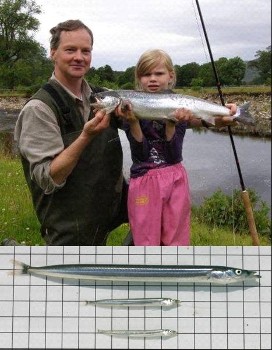Grilse recovery follows summer of sandeels
Posted: Monday 15 November, 2010 @ 10:34:52

The 2010 salmon angling season in Wester Ross started slowly. River levels remained low throughout May and June. Anglers and ghillies were frustrated; very few salmon were caught. However, as local schools broke up for the summer holidays at the beginning of July, the rains arrived. Many rivers subsequently reported catching fresh salmon and grilse ‘off almost every tide’ for the remainder of the summer. For the WRFT area as a whole, the rod catch of salmon for the 2010 season may have exceeded the 2007 total: the highest for more than 20 years.
Over 400 salmon were caught from the River Carron. This is by far the highest total rod catch of salmon for the river on record, exceeding the previous figure of just over 260 taken in 2007. The majority of fish were grilse. The largest was a cock salmon of 28.5lb taken by WRFT Trustee, Richard Wilson. Each year, many thousands of salmon fry, parr and smolts are released into the River Carron to supplement natural production. While fish biologists and geneticists continue to assess the pros and cons of large-scale stocking programmes, Bob Kindness, supported by the River Carron proprietors and local fish farm companies, has demonstrated that a river which has all but lost its salmon fishery can be revived.
Elsewhere, around 300 salmon were caught from the Gruinard River, and around 230 from the River Ewe system. The Dundonnell (see photo), Balgy, Ling and Glenmore rivers all reported good or exceptional catches of salmon. All rivers in Wester Ross release the majority of rod caught fish. Further afield, around the north and east of Scotland, records have been broken for many rivers, from the Thurso to the Tweed (see reports in ‘Trout and Salmon’, November 2010). In eastern Canada many Atlantic salmon rivers around the Gulf of St Lawrence have also had good returns (Atlantic Salmon Federation). And in western Canada, the Fraser River in British Columbia saw the best runs of Sockeye salmon for many years.
Wet summers are good for salmon fishing in Wester Ross. In most rivers salmon can only be caught when rivers levels are higher than normal, following rainfall. The SEPA graph for the River Ewe shows how levels rose at the beginning of July and remained favourable for both the entry of fish and angling through much of July, August and September. However, reports of exceptional grilse runs and the earlier arrival of grilse indicate that there was more to the 2010 bumper angling season than good fishing conditions.
2009: The year of the sandeel?
Last year we reported on a glut of sandeels around Wester Ross. During the summer of 2009, exceptionally ‘fat’ sea trout were caught around Wester Ross. The explanation was that there was a great abundance of sandeels in local waters in summer 2009, both Lesser sandeel age 0+ (young of the year) of only a few cm long, and larger Greater sandeel of 10cm or more. Studies of post-smolt salmon have shown that an abundance of sandeels is of great importance to post-smolt salmon in their first few weeks at sea. Not only do the 0+ sandeels provide a perfect food source for salmon (Haugland et al., 2006), sandeels provide a food source for many of the potential predators of salmon smolts as they enter the sea, and an abundance of them may be a key factor in reducing high smolt and post-smolt mortality (Svenning et al., 2005).
One explanation for the glut of sandeels in 2009 was that sea temperatures in the northeast Atlantic had been cooler during the winter of 2008 – 2009 than in preceding years. However, note that sea and climate conditions in the North Atlantic are currently in a state of flux. At the time of writing, the extent of Arctic sea ice is near the 1979-2010 low for the time of year (NSIDC), with unusually warm sea surface temperatures around Greenland. Some animals may do well with warmer sea temperatures; however some fishes which rely on summer fat reserves to survive the dark days of winter are likely to metabolize faster and lose condition faster if the seas are warmer.
Sandeels, herring and sprats all lay their eggs on the sea bed. The Marine (Scotland) Act and the UK Marine and Coastal Access Act both contain new powers to designate Marine Protected Areas around Scotland (draft Guidelines for Designation of MPAs). Can MPAs help to secure an abundance of juvenile ‘food fish’ for salmon, sea trout and other marine wildlife around our coasts?
*Following a survey of the seabed from Loch Gairloch to Loch Broom during the summer of 2010 led by SNH, a meeting will take place in Gairloch High School on Wednesday 15th December 2010 at 7pm to review some of the findings and learn more about some of the marine wildlife, including fish populations, around our shores. For more information, please contact Peter Cunningham, info@wrft.org.uk.